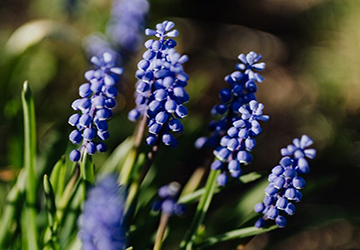There's something incredibly satisfying about growing your herbs at home. Not only does it bring a sense of accomplishment, but it also provides you with a readily available supply of fresh, aromatic herbs right at your fingertips. Making your herb yard is worthwhile and pleasurable, regardless of whether you have a large yard or a little balcony. In this article, we'll guide you through growing your herb garden, from choosing the right location to harvesting and pruning your herbs.

Select The Suitable Location:
The correct place must be chosen as the first stage in creating a successful herb garden. Choose a location with at least 6 hours of bright sunshine each day since most herbs need plenty of sunlight to grow. Examine your outside space and mark any spots that satisfy this requirement. Consider employing containers or vertical gardening techniques to increase your growing area if your outdoor space is restricted. Additionally, ensure it is simple to maintain and water the area.
Selecting The Herbs To Grow:
When choosing herbs for your garden, the options are vast. Consider your culinary tastes and the spices you frequently use in your dishes. Mint, thyme, rosemary, Basil, and cilantro are popular growing herbs. Research each herb's requirements and growth habits to ensure they are compatible with your climate and gardening conditions. It's also worth exploring herbs with medicinal properties, such as chamomile or lavender, to enhance the diversity of your garden.
Preparing The Soil:
Before you embark on your herb gardening journey, let's talk about the importance of soil preparation. A strong foundation for your herbs is key to their growth and success. So, grab your gardening gloves, and let's dive into the world of soil preparation!
First, it's essential to assess the quality of your soil. You can use a home testing kit or contact your local agricultural extension service for a more comprehensive analysis. This soil test will provide valuable insights into its composition and help you identify any necessary amendments or adjustments.
When it comes to herbs, most of them thrive in well-draining soil with a slightly acidic to neutral pH level. So, let's focus on creating the ideal environment for your leafy friends. If your soil needs more nutrients or drainage, fret not! We have a solution for you.
Once your soil is prepped and ready, it's time to start planting your herbs. Choose a sunny spot in your garden, or consider using containers if space is limited. Remember to follow the planting guidelines for each herb, as they may have specific spacing requirements.
Starting From Seeds Or Seedlings:
Your next choice will be whether to grow the herbs from seed or buy seedlings from a nearby nursery. Both approaches are beneficial and depend on time, convenience, and accessibility. You may choose from a greater variety of herb kinds by starting from seeds, and it can be rewarding to see the plant grow from seed to mature. It does, however, take more time and patience. However, utilizing seedlings gives you a head start and increases your chance of success, especially if you're a rookie.

Planting Techniques:
Follow each herb's recommended spacing and planting depth, as overcrowding can lead to poor growth and increased disease susceptibility. Gently loosen the roots of seedlings before planting to encourage healthy root development. If you're transplanting herbs from containers, handle them carefully to avoid damaging the roots. Water the newly planted herbs thoroughly to settle the soil around the roots.
Watering And Moisture Control:
Your herb garden's health and vitality depend on proper irrigation. The majority of plants want constant rainfall that doesn't cause wilting. Set up a watering schedule depending on the requirements of your herb and the current weather. You may require watering more regularly when the weather is hot and dry. Mulching may help keep the soil wet and stop weed development by spreading it around the underside of the plants. But be careful not to overwater—this might result in root rot and other problems.
Fertilizing And Nutrient Management:
Providing your plants with enough nutrients is crucial to encourage healthy development and productivity. Pick a fertilizer appropriate for herbs and use it as the manufacturer directs. Compost and well-decomposed manure are both great organic fertilizers for environmentally friendly gardening. To offer a consistent supply of nutrients, think about putting slow-release fertilizers into the soil. Check your plants often for any indications of nutrient deficiency, and then change your fertilization schedule as necessary.
Disease and Pest Management:
Herb gardens are prone to illnesses and pests, just like any other type of garden. Aphids, snails, and slugs are common pests that can harm plants. These pests can be managed without using hazardous pesticides through natural pest control techniques, such as companion gardening or the introduction of beneficial insects, such as ladybirds. The danger of infections can also be reduced by maintaining proper garden sanitation, such as clearing away waste and fallen leaves. To safeguard your herbs, if required, employ ecologically friendly and organic pest and disease management techniques.
Harvesting And Pruning:
One of the greatest joys of having an herb garden is harvesting fresh herbs for culinary and medicinal purposes. Herbs have the best flavor and potency when they are harvested at the proper time. Learn about the individual needs of the herbs in the garden because each has its rules for harvesting. Herbs should ideally be gathered in the early hours when the essential oils are strongest. Use clean, razor-sharp scissors or pruning shears to prevent harming the plants. Regular herb trimming promotes bushier growth while keeping plants from being lanky and unproductive.
Conclusion:
Growing your herb garden at home is a delightful and rewarding experience. It provides a continuous supply of fresh herbs for cooking, aromatherapy, and medicinal purposes.



